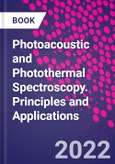Photoacoustic and Photothermal Spectroscopy: Principles and Applications introduces the basic principles, instrumentation and major developments in the many applications of Photoacoustic and Photothermal Spectroscopy over the last three decades. The book explains the processes of sound generation by periodic optical excitation and ultrasonic generation by pulsed laser excitation and describes the workings of photoacoustic cells equipped with microphones and piezoelectric transducers. Photoacoustic imaging (PAI) is one of the fastest-growing imaging modalities of recent times. It combines the advantages of ultrasound and optical imaging techniques.
These non-invasive and non-destructive techniques offer many benefits to users by enabling spectroscopy of opaque and inhomogeneous materials, (solid, liquid, powder, gel, gases) without any sample preparation, and more.
Please Note: This is an On Demand product, delivery may take up to 11 working days after payment has been received.
Table of Contents
I. Basic physics and instrumentation1. Photoacoustic and photothermal spectroscopy: Fundamentals and recent advances
2. Physics and instrumentation for photoacoustic spectroscopy of solids
3. Physics and techniques of photoacoustic spectroscopy of liquids
4. Electret microphone for photoacoustic spectrometer and a simple power meter
5. Design, characterization and applications of photoacoustic cells
6. Photoacoustic instrumentation for life sciences
7. Ultrafast Laser Induced Photothermal Spectroscopy
8. Thermo-optic techniques: A tool for interdisciplinary studies
9. Photothermal effects in optical materials
10. Photopyroelectric spectroscopy: a direct photothermal technique to evaluate thermal properties of condensed matter
II. PAS and PTS applications
11. Photothermal studies in semiconductor materials
12. Photoacoustic spectroscopy of some layered systems and Rare-Earth ions
13. Photoacoustic studies on neutron irradiated RE-oxide powder and ?- irritated Nd-doped glasses
14. A comparative Investigation of polymers exposed to neutrons, protons and ?-rays using optical and photoacoustic techniques
15. Photoacoustic and optical spectroscopy of dye-coated plasmonic thin films of silver and gold?
16. Photoacoustic studies on organic dye solutions
17. Photoacoustic spectroscopy of liquid samples and polluted water
18. Photoacoustic spectroscopy of gases and harmful vapours
19. Thermal lensing spectroscopy of hydrocarbon molecules
20. Photoacoustic spectroscopy of diatomic and polyatomic molecules
21. Laser photoacoustic spectroscopy of explosives and drugs
22. Laser Photoacoustic and Photothermal Spectroscopy for Homeland Security and?Defense
23. Photoacoustic Spectroscopy: A novel optical characterization technique in Agricultural science
24. Photoacoustic spectroscopy of foodstuff
25. Application of modulated optical excitation in the investigation and cure of diseases
26. Applications of optical and photothermal excitations in cervical and breast cancers
27. Applications of photoacoustic spectroscopy in gastroenterology
28. A Comparative account of PAS and LIBS for compositional studies of gallbladder stones
29. Photoacoustic imaging of the mouse brain to get insights into the human brain
30. Photoacoustic Tomography and its Applications








